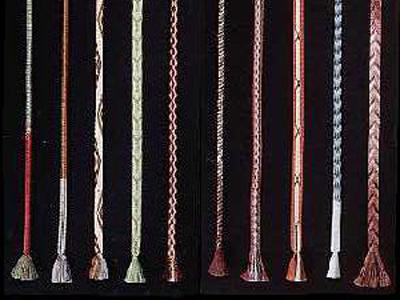江戸くみひも Edokumihimo Edo Braiding
|
Edo braiding is a tasteful and graceful Tokyo specialty.
Japan makes extraordinarily sophisticated use of all kinds of threads. Not only do the Japanese bind and tie things together with strings and thread, but they also can show fortune, sex and status by the way the threads are tied together, by the choice of color and by the arrangement of the knots.
Braiding dates back to before the Edo period. It was originally imported from China or Korea. When the Shogunate was established in Edo, there was a demand for ceremonial clothing and therefore for braids. The Edo braid then developed a delicacy and a wabi-sabi quality (quiet simplicity).
Edo braiding is applied to many things, such as the obi sash for kimonos, haori (short jackets) and other essentials for our daily lives.
Braiding is also used to secure scrolls, on monks robes, on sashes worn by nobility, as decoration on traditional armory and on sword handles.
Japan makes extraordinarily sophisticated use of all kinds of threads. Not only do the Japanese bind and tie things together with strings and thread, but they also can show fortune, sex and status by the way the threads are tied together, by the choice of color and by the arrangement of the knots.
Braiding dates back to before the Edo period. It was originally imported from China or Korea. When the Shogunate was established in Edo, there was a demand for ceremonial clothing and therefore for braids. The Edo braid then developed a delicacy and a wabi-sabi quality (quiet simplicity).
Edo braiding is applied to many things, such as the obi sash for kimonos, haori (short jackets) and other essentials for our daily lives.
Braiding is also used to secure scrolls, on monks robes, on sashes worn by nobility, as decoration on traditional armory and on sword handles.
- address
- Kiryudou K.K. 1-27-6 Kiyokawa, Taito-ku, Tokyo, 167-0022
- name
- Edo Braid Patrimony Association
- phone
- 03-3873-2105














